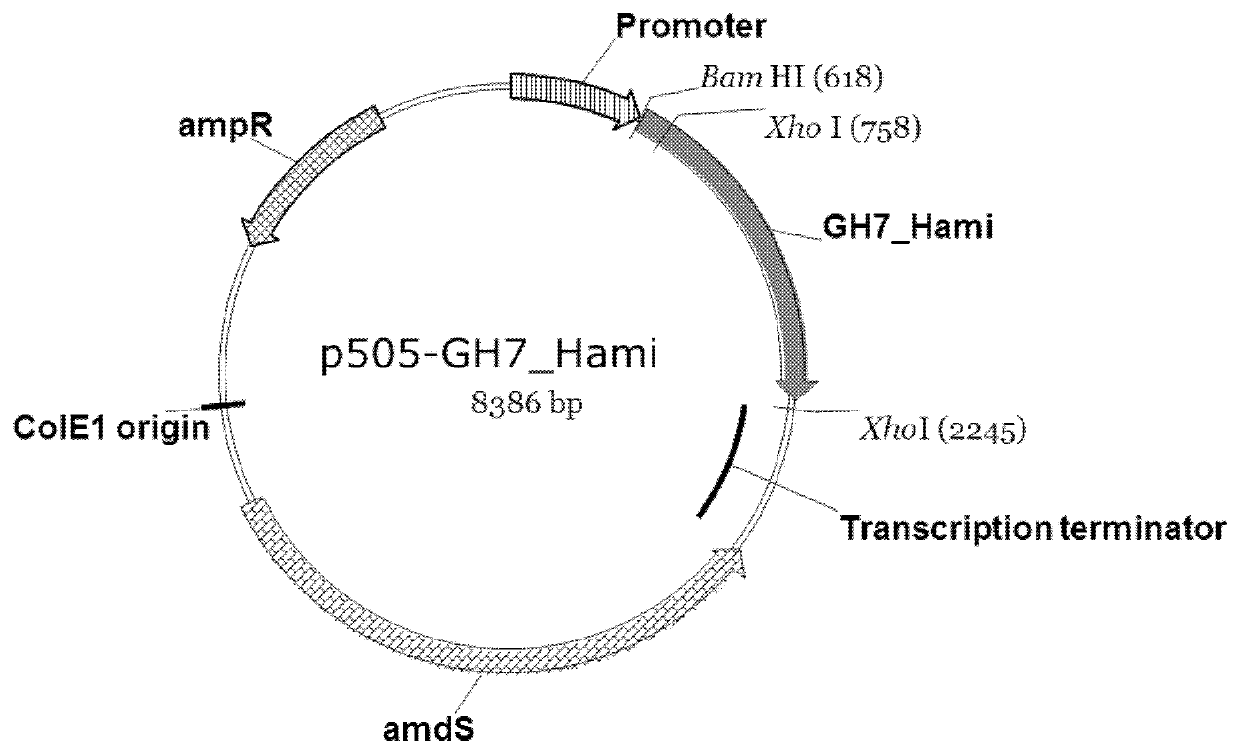Polypeptides having cellobiohydrolase activity and polynucleotides encoding same
a technology of polynucleotide encoding and cellobiose, which is applied in the field of polypeptides having cellobiose hydrolase activity and polynucleotides encoding same, can solve the problems of undesirable accumulation of cellobiose during hydrolysis and the loss of ethanol yield
- Summary
- Abstract
- Description
- Claims
- Application Information
AI Technical Summary
Benefits of technology
Problems solved by technology
Method used
Image
Examples
example 1
Hamigera sp. NN046817 Genomic DNA Extraction
[0372]Hamigera sp. strain NN046817 was inoculated onto a PDA plate and incubated for 3 days at 37° C. in the darkness. Several mycelia-PDA plugs were then inoculated into 500 ml shake flasks containing 100 ml of YPG medium. The flasks were incubated for 3 days at 37° C. with shaking at 160 rpm. The mycelia were collected by filtration through MIRACLOTH® (Calbiochem) and frozen under liquid nitrogen. Frozen mycelia were ground, by a mortar and a pestle, to a fine powder, and genomic DNA was isolated using a DNeasy® Plant Maxi Kit (QIAGEN) following the manufacturer's instruction.
example 2
Genome Sequencing, Assembly and Annotation
[0373]The extracted genomic DNA samples were delivered to Fasteris (Switzerland) for genome sequencing using an ILLUMINA® HiSeq 2000 System (Illumina, Inc.). The raw reads were assembled at Fasteris using the SOAPdenovo program (Li et al., 2010, Genome Research 20: 265-72). The assembled sequences were analyzed using standard bioinformatics methods for gene identification and function prediction. GeneMark (Ter-Hovhannisyan V et al., 2008, Genome Research 18(12): 1979-1990) was used for gene prediction. Blastall version 2.2.10 (Altschul et al., 1990, J. Mol. Biol. 215(3): 403-410 and HMMER version 2.1.1 (National Center for Biotechnology Information (NCBI), Bethesda, Md., USA) were used to predict function based on structural homology. The GH7 family cellobiohydrolase polypeptides were identified directly by analysis of the Blast results. The Agene program (Munch and Krogh, 2006, BMC Bioinformatics 7: 263) and SignalP program (Nielsen et al.,...
example 3
Cloning of the Hamigera sp. GH7 Cellobiohydrolase I Gene from Genomic DNA
[0374]The GH7 cellobiohydrolase I gene, GH7_Hami (SEQ ID NO: 1 for the genomic DNA sequence and SEQ ID NO: 2 for the deduced amino acid sequence), was selected for expression cloning.
[0375]Based on the DNA information obtained from genome sequencing, oligonucleotide primers, shown below, were designed to amplify the coding sequence of the GH7 cellobiohydrolase I from the genomic DNA of Hamigera sp. strain NN046817. The primers were synthesized by Invitrogen, Beijing, China.
[0376]
Forward primer:(SEQ ID NO: 3)5′-ACACAACTGGGGATCCACCatggctgctacaaaatcttaccgaatctac-3′Reverse primer:(SEQ ID NO: 4)5′-CCCTCTAGATCTCGAGacgtaacttctccagccgtctctc-3′
[0377]Lowercase characters of the forward primer represent the coding region of the gene and lowercase characters of the reverse primer represent the flanking region of the gene, while bold characters represent a region homologous to insertion sites of pCaHj505 (WO2013029496). The...
PUM
| Property | Measurement | Unit |
|---|---|---|
| pH | aaaaa | aaaaa |
| pH | aaaaa | aaaaa |
| volume | aaaaa | aaaaa |
Abstract
Description
Claims
Application Information
 Login to View More
Login to View More - R&D
- Intellectual Property
- Life Sciences
- Materials
- Tech Scout
- Unparalleled Data Quality
- Higher Quality Content
- 60% Fewer Hallucinations
Browse by: Latest US Patents, China's latest patents, Technical Efficacy Thesaurus, Application Domain, Technology Topic, Popular Technical Reports.
© 2025 PatSnap. All rights reserved.Legal|Privacy policy|Modern Slavery Act Transparency Statement|Sitemap|About US| Contact US: help@patsnap.com


